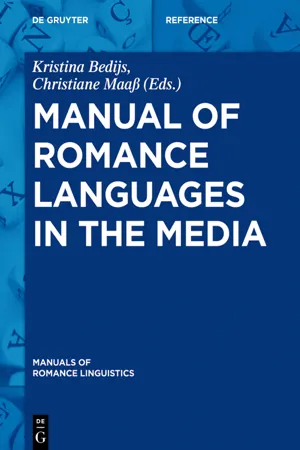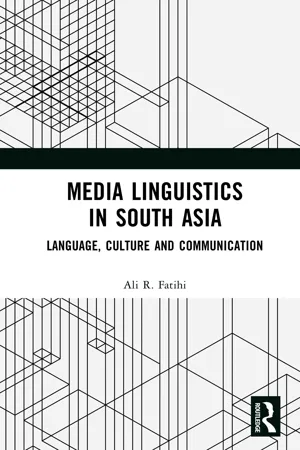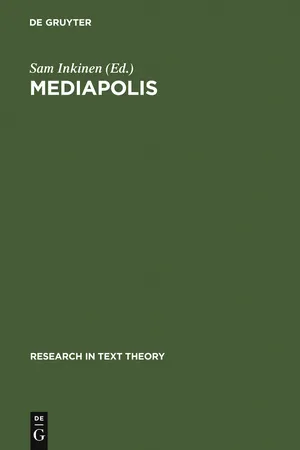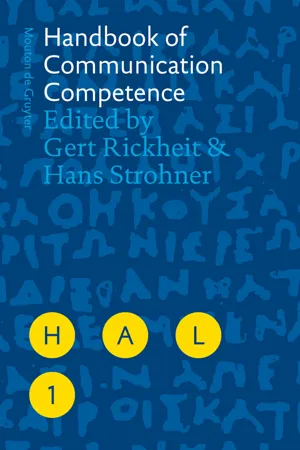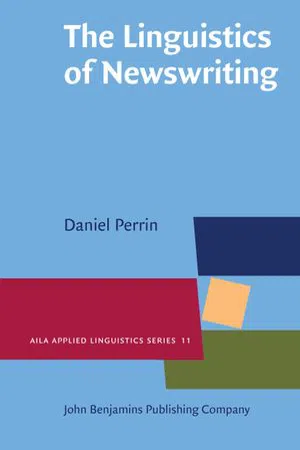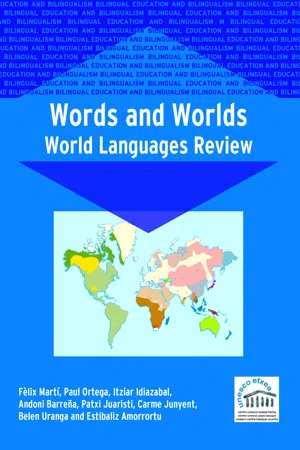Languages & Linguistics
Media Linguistics
Media linguistics is the study of language as it is used in various forms of media, such as television, radio, and the internet. It examines how language is used to convey meaning, shape public opinion, and influence behavior in the media environment. This field explores the relationship between language and media, including the impact of media on language use and vice versa.
Written by Perlego with AI-assistance
Related key terms
1 of 5
9 Key excerpts on "Media Linguistics"
- eBook - ePub
- Kristina Bedijs, Christiane Maaß, Kristina Bedijs, Christiane Maaß(Authors)
- 2017(Publication Date)
- De Gruyter(Publisher)
Media and LinguisticsPassage contains an image Kristina Bedijs and Christiane Maaß
0Preface
This manual in the series of Romance Linguistics is dedicated to the use of Romance languages in the media. It focuses on media linguistic research on Romance languages and media linguistic approaches from Romance countries and Romance studies. Today, media culture is clearly global, but media content is delivered in different (also Romance) languages and is part of language-bound discourses. Unlike in everyday language, where “media” usually means analog or digital messages, the term “media” in media and communication studies and linguistics is a rather broad one, and so is the term “message”. “Media” can mean the air carrying acoustic waves from a mouth to an ear; it can mean the wire between two landline telephones carrying electronic signals converted from speech; it can mean an application on a smartphone which displays text and pictures sent from another smartphone; it can mean a radio receiver.No manual of linguistics can cover all media in the broadest sense of the term. Besides the fact that much research has been done on fundamental questions by media and communication studies, there has also been research from the linguistic perspective for decades. Nonetheless, the articles in this volume cite and reflect the most relevant publications in their respective fields. Print media have long been the basis of both communication studies and Media Linguistics, and investigations of the language in newspapers abound (cf., e. g., the volume edited by Dahmen et al. 2006 and the overview in Wilhelm 2006) – not only because these media are the oldest, but also because they provided easy access for linguistic research even before the computer-assisted possibilities of analysis had emerged: text and visuals were directly available without technological aid. Such media are called “secondary media” in the terminology of Pross (1972): they require technical devices only on the sender’s side. - eBook - ePub
Media Linguistics in South Asia
Language, Culture and Communication
- Ali R Fatihi(Author)
- 2022(Publication Date)
- Routledge India(Publisher)
Media Linguistics makes a broad claim about linguistic representation in a media text. It suggests that whole sets of media texts have linguistic commonalities that are to be investigated in Media Linguistics. Language of media has increasingly been used as research data in both structurally and typologically oriented as well as sociolinguistic research (e.g. Fatihi 2001, Janurik 2017 on code-switching, Jalava 2014 on variation and change in grammatical structures, Mantila 2010 on standardization), but there have not been many studies where the language of media has been made the direct object of analytical research. There are a few examples that may be considered an exception in this comparison because they have attracted studies representing different fields and have also been placed within a larger media context (Vincze 2013, Vincze and Holley 2013). It suggests that media texts had not been subject to large-scale studies before a British scholar John Corner presented a talk at the British Association of Applied Linguistics Conference on “The Scope of Media Linguistics”, in 1998 which launched systematic media analysis. It advocates that the term “Media Linguistics” was introduced relatively recently in the year 1998 in academic discourse, Two years later in 2000 the term was again used in a thesis entitled “Theory and Methods of Media Linguistics” submitted for the award of a PhD degree by Tatiana Dobroskionskaya. The unsurpassed work that linguists have done thus far in communication studies was to remove vague and equivocal statements about the reciprocal relationship between society and communication. The theoretical models spun out by these linguistic studies are often not so much a statement of the relationship between a hypothesis and data as an attempt to rephrase old propositions in new jargon - eBook - PDF
- Rowela S. Basa(Author)
- 2019(Publication Date)
- Society Publishing(Publisher)
The Speech is part of language, and language is very vast than speech. Even though spoken language has often been honored within phonology at the cost of another language, language has interchangeably been a symbol or has been left without assessment grant on visual and aural media forms. The Media Anthropology and Literacy are subjects of deep study within this series. The English brought together the studies accepting hypothetical and procedural methods containing language anthropology, variationist sociolinguistics, sociology of language, media, and discourse studies that address the study of language and media, media is learned as text that is writing, print, aural that is radio, music, sound, visual that is television, film, and digital computer messaging, and that put up queries in front of linguists that is it possible that media should come up with the idea of standardization of language practices. Regardless of expectations to the opposite, the availability of radio broadcasting has failed to reduce regional linguistic differences in the twenty centuries. Whether and how new communicative technologies mediate in current processes of language invention is a promising arena for research. The user and viewers background will affect the meaning of resources whereas the medium will affect the way messages are received. The most relevant step to gain knowledge about media and news about the world is to the way in which thoughts and meaning are passed through and by many types of media and other data agencies, such as libraries, archives, museums, and the Internet. The phases that have the task to suggest meaning differently in its own language or grammar. The Language in this context is defined as the methodological and representative elements or encryptions Language and Society 56 and conventions that media and information workers must choose and implement in a process to disperse the ideas, information, and knowledge. - eBook - PDF
- J.L. Mey(Author)
- 2009(Publication Date)
- Elsevier Science(Publisher)
Much of this research was quantitative, relying on coding aspects of content into a number of discrete categories and counting their frequency. Later content analyses applied a similar methodology to television, but just about every type of media communication has been studied. Modern content analysis is still used for news content or detecting political bias, but it has also been used to investigate topics like gender representa-tion in advertisements, violence in children’s television programs, and representations of minority groups (for example, the work of the Glasgow Media Group in the United Kingdom on the news; and the research by George Gerbner and his associates in the United States on the Cultural Indicators project). The first edition of the Encyclopedia of language and linguistics included an article on media language as part of the communicative process and outlined a different and more theoretically based tradition in the study of media language. It started with semiotics to demonstrate the need to think of media language as part of a sign system or as a process of communica-tion with complex social and cultural influences affecting the way in which media texts are produced and understood. The article reviewed the major approaches to the study of media language, such as critical linguistics, noting its approach to ideology and power in the representation of social reality, and its agenda in unmasking the seemingly objective na-ture of news reports; semiotics, especially as a way of decoding both verbal and visual aspects in advertise-ments; and discourse analysis, again primarily of news texts, but also phone-ins, interviews, and disc jockey monologues, with an emphasis on pragmatics, speech acts, and turn-taking. It noted a shift in em-phasis away from textual analysis alone towards a more audience-focused approach. - eBook - PDF
Mediapolis
Aspects of Texts, Hypertexts und Multimedial Communication
- Sam Inkinen(Author)
- 2012(Publication Date)
- De Gruyter(Publisher)
MARCELLO LA MATINA Media and Languages From Nelson Goodman's Philosophy of Languages to a Scheme for a Semiotic-Philological Theory of Communication Philosophers sometimes mistake features of discourse for features of the subject of discourse. [...] According to this line of thinking, I suppose that before describing the world in English we ought to deteimine whether it is written in English, and that we ought to examine very carefully how the world is spelled. - Nelson Goodman, Problems and Projects, p. 24. 0. Forward: Media as Languages? The media repeatedly attract the attention of those who work in the field of com-munication. They are also of interest to scholars (linguists, philosophers, mass-communications experts, etc.). In spite of such multifarious interest, the question What exactly are media? still today remains full of meaning. Latin etymology is of little use to us: medium is the intermediary between two or more things, and thus is what provides a contact between two universes, which are really or only virtually connected. Media, therefore, are related to interaction, social behaviour and communication in the broad sense. But, stricto sensu, how do they involve language and the various disciplines of communication? And in what way is a mediologist also a scholar of language? Essentially, people talk about media in three ways. In the first sense they are viewed as technologies which are capable of substituting a given human faculty, widening its importance. The discoverer of media, McLuhan, saw them as play-ing a leading role in social life and as instruments of authentic revolutions. The characteristic of media when considered as technologies lies in the fact that they embody their meaning or, rather, their message. They absorb the interest of their users and, if they assume a content, it is at most another medium that is thus inte-grated into the first. Media technologies are not instruments of deferment but cat-alysts. - eBook - PDF
Language in the Media
Representations, Identities, Ideologies
- Sally Johnson, Astrid Ensslin(Authors)
- 2007(Publication Date)
- Continuum(Publisher)
Indeed, we are engaged in an almost constant process of encoding and decoding linguistic and non-linguistic messages. Consequently, we are subjected to, as well as in control of, a plethora of technological and medial information flows that both construct and transfer ideologies between ourselves, our information providers, and our target audiences. The 'media' in their broadest sense encompass not only the classical communication channels they are commonly associated with, i.e. in chrono-logical order of their evolution, newspapers/magazines, radio, cinema, television, and the new electronic media - the latter comprising per se a con-tinuously expanding spectrum of digital technologies and communicative practices. 5 More widely, the term 'media' also covers any tools and techni-ques employable by intelligent mammals to carry out, consciously or uncon-sciously, an unlimited range of highly specific signifying practices. These 11 Solly Johnson ond Astrid Ensslin semiotic routines extend, at a personal, micro-cultural level, to clothes, hair-styles, gaits, and body language whereas, at a macro-cultural level, 'public' or 'collective' meanings are denoted and connoted by posters, road signs, archi-tecture and advertising (Bignell 2002:1). Finally, language itself may be subsumed under this wider notion of mediality (see McLuhan 1964), not least because it operates at both a micro-and macro-cultural level. Language thereby forms, along with the visual image, the most powerful communica-tive tool available to social actors. In this book, we refer to 'the media' in the sense of communication or 'mass' media. As a collective noun derived from the Latin medium (means, method), the lexeme has adopted singular grammatical 'behaviour' despite the fact that, unlike any other member of its class, it embodies an increasing sense of plurality and diversity. - eBook - PDF
- Gert Rickheit, Hans Strohner, Gert Rickheit, Hans Strohner(Authors)
- 2008(Publication Date)
- De Gruyter Mouton(Publisher)
Journalistic communication translates between the languages of communities, such as between the languages of text actors and addressees. By doing so it overcomes social differences – and at the same time consolidates them. The theoretical question of interest for linguistics at this in-terface of social language function and media competence is how communities differ in their languages and language variants and how language use changes – also under the influence of journalistic media. From the point of view of prac-tice, the question arises as to how to reliably reach different addressees with lin-guistic means while at the same time defining a unique profile in the market and committing audience, sources, and advertising clients over the long-term. Media Linguistics can employ tools from sociolinguistics to identify and con-sider the corresponding language competence with which media professionals commit their target groups – so-called audience design. Audience design refers to tailoring a media item for certain target groups: a) adjusting to the expectations, prior knowledge, and receptiveness of address-ees; b) using a different style from other offers in the market; and c) contributing to the commitment of users. - eBook - PDF
- Daniel Perrin(Author)
- 2013(Publication Date)
- John Benjamins Publishing Company(Publisher)
The technology of each medium allows its own interaction of symbolic systems, and the dramaturgy demands it: print with its script and still pictures; television with moving pictures; and radio with the accoustic background of reported events. From the practice point of view, the question arises as to how signs from several systems can be coordinated with each other. Media Linguistics employs tools from semiotics to analyze how lan-guage is used to create multi-semiotic media items – for example to avoid a gap between spoken text and pictures, the text/image divide (e.g. Hess-Lüttich, 2002; Holly, 2005; Wojcieszak, 2009; overview in Perrin, 2011b, 115–117). However, when focusing on newswriting , Media Linguistics investigates not only modal interplays in products, but also modal transitions in processes. An example from the Yogy case is the practice of Writing for speaking: C.A. changed single words in his emerging text to facilitate the speaking of the lan-guage chunks in the booth (Ex. 6 and Ex. 7) . 1025 j’ai inversé des choses 1026 «tout le boeing» c‘est plus difficile à dire 1027 que «tout l’appareil» … … 1030 oui mais ce n’est pas moi qui vais le lire 1031 mais je dois penser quand même oui Ex. 6 Verbal protocol from the Y OGY case Source: tsr_tj_070307_1930_ayer_yogyakarta_verbal Moi 43 {,} 43 | 44 j’ai sauté d 49 [e 40 [ l’avion] 40 | 41 41 { 42 [la^’| 42 ] 42 l’appareil} 41 ] 49 | 43 | 50 50 {u B 51 {o} 51 | 52 eing| 51 } 50 et quelques minutes après 46 [l’ensemble d 44 [e l’avion] 44 | 45 45 {u} 45 | 46 ] 46 | 47 47 { 48 [tpout| 48 ] 48 t out } 47 | 49 52 {lappareil était en feu} 52 Ex. 7 Revisions from the Y OGY case Source: tsr_tj_070307_1930_ayer_yogyakartatemoignage_snt 84 The Linguistics of Newswriting Part C C|1.5 Language environments and activity fields of newswriting In practice, newswriting takes place across the theoretically separate envi-ronments outlined above (C|1.1–1.4) . - eBook - PDF
Words and Worlds
World Languages Review
- Fèlix Martí, Paul Ortega, Itziar Idiazabal, Andoni Barreña, Patxi Juaristi, Carme Junyent, Belen Uranga, Estibaliz Amorrortu(Authors)
- 2005(Publication Date)
- Multilingual Matters(Publisher)
Chapter 7 Languages and the Media The use of a language in the media has a fundamental effect, both from the internal point of view of the language itself, and from the external point of view of the status of the language. On an internal level, the media are responsible for the development of specific oral and written genres, as well as the corresponding discursive, grammatical and lexical forms. Oral and written forms in the media can have so much influence that the linguistic varieties they use are the fundamental points on which many of today’s standard languages are based. So-called British Broadcasting Corporation (BBC) English is the classic and most paradigmatic example of this. From the point of view of status, the media also contribute decisively to the prestige and vitality of languages and can do so negatively or positively. Absence from the media, incorrect, derogatory or disparaging use, would be the most negative extremes of endless ways of damaging a language in the media. On the other hand, the presence and correct (suitable) treatment of languages in the media is today a fundamental way for them to develop a formal and public discourse. In other times, it was religious and festive rituals that provided the necessary commu-nicative contexts for developing this type of prestige. Subsequently, using the language in the media not only fulfils its specific object of allowing communication between members of a linguistic community, but also increases the prestige of the language between people inside and outside the community. In this Review, Xavier Albó puts it as follows: “…if speakers of a discrim-inated language find it is used in favourable contexts in the social media, their self-esteem grows and even the dominant elite can come to accept its presence”. All of this shows how very important it is for languages to have access to the media and therefore how important it is to promote cultural and linguistic diversity in the media.
Index pages curate the most relevant extracts from our library of academic textbooks. They’ve been created using an in-house natural language model (NLM), each adding context and meaning to key research topics.
